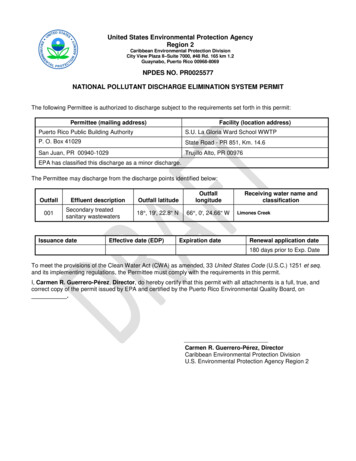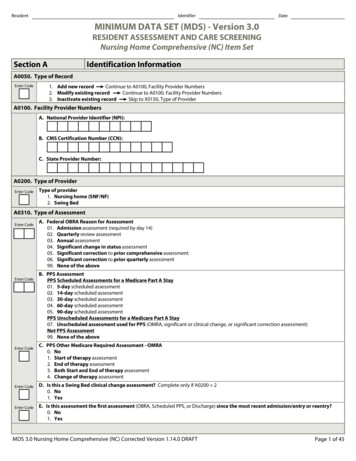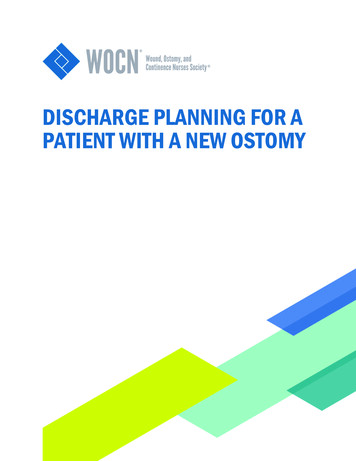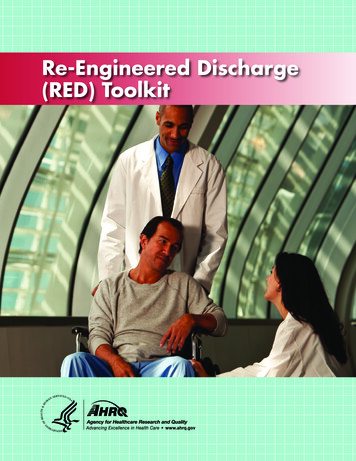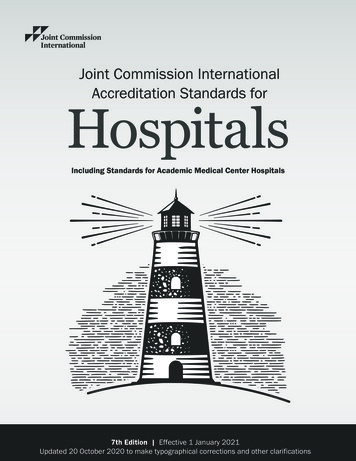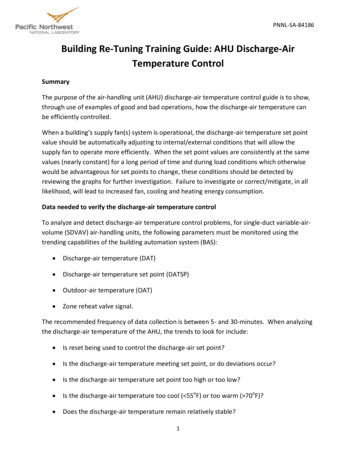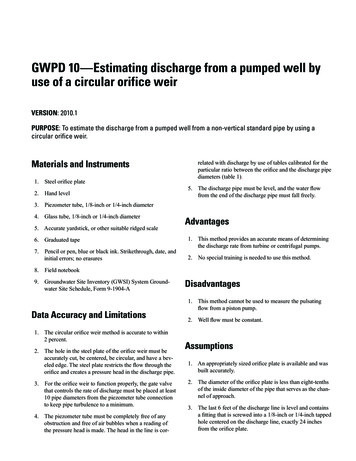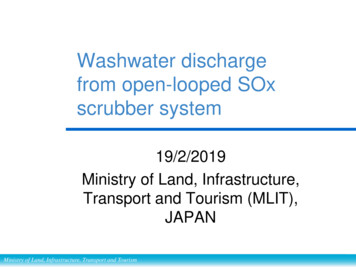
Transcription
Washwater dischargefrom open-looped SOxscrubber system19/2/2019Ministry of Land, Infrastructure,Transport and Tourism (MLIT),JAPANMinistry of Land, Infrastructure, Transport and Tourism
Outline1. Introduction2. Basic understandings of the risks tohuman health and marine environment bySOx emission3. Investigation on the effects of dischargedwater from scrubber4. Conclusion1
1. Introduction2
International Regulation and Possible Solutions% Sulphur% Sulphur Cap by Region54.543.532.521.510.50MARPOL Annex VI Regulation 14Sulphur Oxides and ParticulateMatter (SOx & PM)GlobalEmission Control Area (ECA)3.5% High-SulphurFuel Oil (HSFO)Low sulfur fuel oil・0.5% bunker fuel oil・Marine Gasoil (MGO)LNG-fuelled shipPM, NOx andCO2 can alsobe reducedScrubber (EGCS)Enable to use3.5% HSFO3
Characteristics of ScrubberOpen-LoopedClosed-LoopedHybridExhaust AOHtank中和剤DiagramCleaner �ジタンクSludge tankEngine主機関脱硫済海水Wash waterWashwaterCharacteristicsSea waterDedicated water(usually fresh water)Sea water or dedicatedwater Simple deviceDischarge water More complicatedsystem than open typeFew discharge waterEnable to switchbetween open andclosed mode4
2. Basic understandings of the risks to humanhealth and marine environment by SOx emission5
Basic understanding of the risks to Human Health and MarineEnvironment by SOx emissionBefore Sulphur reductionSecondary production of Particles Matter 2.5of sulphates in the atmospheric conditionsSOxPM2.5SO2SO3Potential Human Health riskPAHsPotential risks onHuman HealthHigh Sulfur Fuel Oil6
the risks to Human HealthPM2.5SOxH2SO4 (NH4)2SO4PAHs Disease of respiratorysystem andcirculatory(cardiovascular)system Skin and Eyesirritation/corrosion etc.The more emission,the higher risk tohuman health7
Basic understanding of the risks to Human Health and MarineEnvironment by SOx emissionAfter Sulphur reduction with Low sulphur fuel oilReduced SOxReduced PM2.5SOxPAHsRisks by PM2.5 willbe mitigated butthere is stillpotential risk tohuman healthexposed by PAHsLow Sulfur Fuel Oil8
Basic understanding of the risks to Human Health and MarineEnvironment by SOx emissionSOx, PM (and others) emission reduction by Open-looped scrubberReduced SOxReduced PM2.5Risks to Human Healtheither by PM2.5 andPAHs will besignificantly mitigatedSOxPAHs?ScrubberSO32Cl-Na SO42-OxidizedPromptDilutionSO42Concentration in thereceiving sea1. Na 19.35 g/kg2. Cl10.76 g/kg23. SO4 2.71 g/kgNeutralize2H PAHs?H2O・NO detectable changes inpH or in sulphate.・How about risks of PAHs?9
Investigation on the effects of discharged water from scrubber3. Investigation on the effects ofdischarged water from scrubber10
The risk on marine organismsSimulation for Dilution of discharged water from stern Using CFD model, the strength of the turbulent flow with vortex (swirls)behind the hull of Panamax (82,000 DWT) was estimated, and thentheoretical dilution rate was calculated. The worst cased discharge water flow from scrubber (main enginesoperated at MCR) is assumed for this simulation.Result . The calculated dilution rate, according to the duration time after 8.1129dilution rate4060805008001,0005,0008,5009,661 The time to reach 500 folds dilution is estimated around 3 seconds after itsdischarge. The time to reach 5,000 folds dilution is estimated about 1 minute after itsdischarge.11
The risk on marine organismsThe result of Whole Effluent Toxicity (WET)Algae(micro stacean)Vertebrate(fish)Ptilohyale(Hyale barbicornis)Adrianichthyidae(Oryzias javanicus)Acute endpoint49%(EC 50)20%(5 folds dilution)(LC 50)35%(LC 50)Exposure time72 hours96 hours96 hoursLC: Lethal ConcentrationEC: Effect Concentration12
The risk on marine organismsAssignment of Assessment Factors(AF) used for deriving PNEC values(Methodology for information gathering and conduct of work of the GESAMP-BWWG)Assessment FactorData-setPNECgeneralPNEC nearshipLowest short-term LC50 from freshwater or marine speciesrepresenting one or two trophic levels10,0001,000Lowest short-term LC50 from three freshwater or marine speciesrepresenting three trophic levels1,000100Lowest short-term LC50 from three freshwater or marine speciesrepresenting three trophic levels at least two short term LC50 fromadditional marine taxonomic groups10010Lowest chronic NOEC from one freshwater or marine speciesrepresenting one trophic level, but not including micro-algae100Lowest chronic NOEC from two freshwater or marine speciesrepresenting two trophic levels, which may include micro-algae50Lowest chronic NOEC from three freshwater or marine speciesrepresenting one trophic level, but not including micro-algae10The reasons for the assessment facto of 1000 are;10 for conversion from acute to chronic10 for cancelling the differed sensitivity among species10 for conversion from LC50 to PNECPNEC general:long-term PNECPNEC near ship:short-term PNECLC50:Lethal Concentration 50%13
The risk on marine organismsSafety dilution rate(short-term)PNEC near ship (short term)LC 50 dilution rate20% (1/5)1/100 Safety dilution rate(long-term)PNEC general (long-term)1/10001/500 1/5000 The time to reach the dilution rate of 500 folds dilution is estimatedaround 3 seconds (see slide 12) after its discharge.Any-short term adverse effects could not be expected because possible exposuretime is significantly shorter than that of WET (ie. 96 hours, as shown in slide 12). The time to reach the dilution rate of 5,000 folds dilution is estimated about1 minute (see slide 12) after its discharge.Any-long term adverse effects could not be expected because the dilutionand diffusion will be continued.Japan concluded that either any short- or long-term effects on marineorganisms cannot be caused by the use of open-looped scrubber.14
The impact on the seawater quality1. Targeted substances for the prediction of long-term concentrationpH, Nitrate, and Chemical oxygen demand (COD) are selected by the screeningprocess for the simulationsSubstances µg/Lµg/Lµg/LDischargewater0.0060.006 0.01 0.005 0.005 0.005 0.005 0.0050.006 0.005 0.0050.0070.006 0.0050.012 0.0050.014 0.005 0.0050.0060.014The amount of detected PAHs respectivelywas only slightly above their detection limitsSubstance unitActualConcentrationof heavy metalDischargecriteria foronland sourcesVanadium µg/L58No criterionNickel µg/L17.9No criterionIron µg/L99710000Zink µg/L48.32000Lead µg/L1.755100Cupper µg/L8.123000Cadmium µg/L0.03530Chrome µg/L22.82000Arsenic µg/L1.02100The actual amount of heavy metals in thedischarge water from scrubber weresubstantially less than the emissionstandard for on land sources in Japan, byorder on 100.15
The impact on the seawater quality2. Selected sea areas for prediction of long-term concentrationSeto sea, Ise sea and Tokyo Bay were selected in terms of their enclosedconditions and ship congestionTokyo BaySeto SeaIse SeaRetrived from Google3. Condition for the prediction10 years accumulated concentration of the substances under the worst-casedscenario(※) were estimated.(※) All ships in these areas will be equipped with open-looped scrubber andwill discharge the wash water16
The impact on the seawater qualityResults of the calculation of the concentration for 10 yearsand comparison with the actual concentration as of 2015Additional Accumulated concentration after 10 yearsItempHNitrate-nitrogen(mg/L)COD(mg/L)Tokyo BayIse BaySeto Inland SeaNO changes (※)(current rage pH 8.3)NO changes (※)(current rage pH 8.2)NO changes (※)(current rage pH 8.1)7.34 10-45.30 10-52.01 10-3(current rage 0.27-0.74)(current rage 0.29-0.54)(current rage 0.14-0.71)3.85 10-48.11 10-7(current rage 2.2-2.9) (current rage 2.4-3.5)9.62 10-4(current rage 1.8-2.7)※ The pH changes caused by the accumulated concentration of sulphates ion and nitrates ion is less than 0.0035.The accumulated concentration by the concerned substances in wash water isless than the current concentration in the respective target areas, by order of 100.(In case only 5% of the ships are installed with scrubbers, the accumulatedconcentration is less by order of 2000.)17
Conclusion Scrubbers enable to mitigate potential risks to humanhealth by reducing harmful substances;not only SOx and PM, but also PAHs and other materialsthat would otherwise be emitted into the atmospheric air. Japanese government assessed the potential risks tomarine environment by discharged water from scrubber. Japan concluded that the discharge water with chemicalsubstances such as SOx, PAHs and heavy metals canNOT cause unacceptable effects either on the marineorganisms or on the seawater quality around Japan. Therefore, Japan is of the position that there would NOTbe a scientific justification to prohibit the use of openlooped scrubber, as long as the IMO’s discharge criteriawere met.18
Which is better?PAHsSOxSulphur 0.5% Fuel OilWITHOUT ScrubberPM2.5PAHs?SOxSulphur 3.5% Fuel OilWITH ScrubberPM2.5H SO42PAHs?etc19
JAPAN . Outline 1. Introduction 2. Basic understandings of the risks to human health and marine environment by SOx emission 3. Investigation on the effects of discharged . SOx, PM (and others) emission reduction by Open-looped scrubber Reduced SOx Reduced PM 2.5 Na 1. Na 19.35 g/kg 2. Cl-10.76 g/kg 3. SO 4 2-2.71 g/kg Concentration in the

